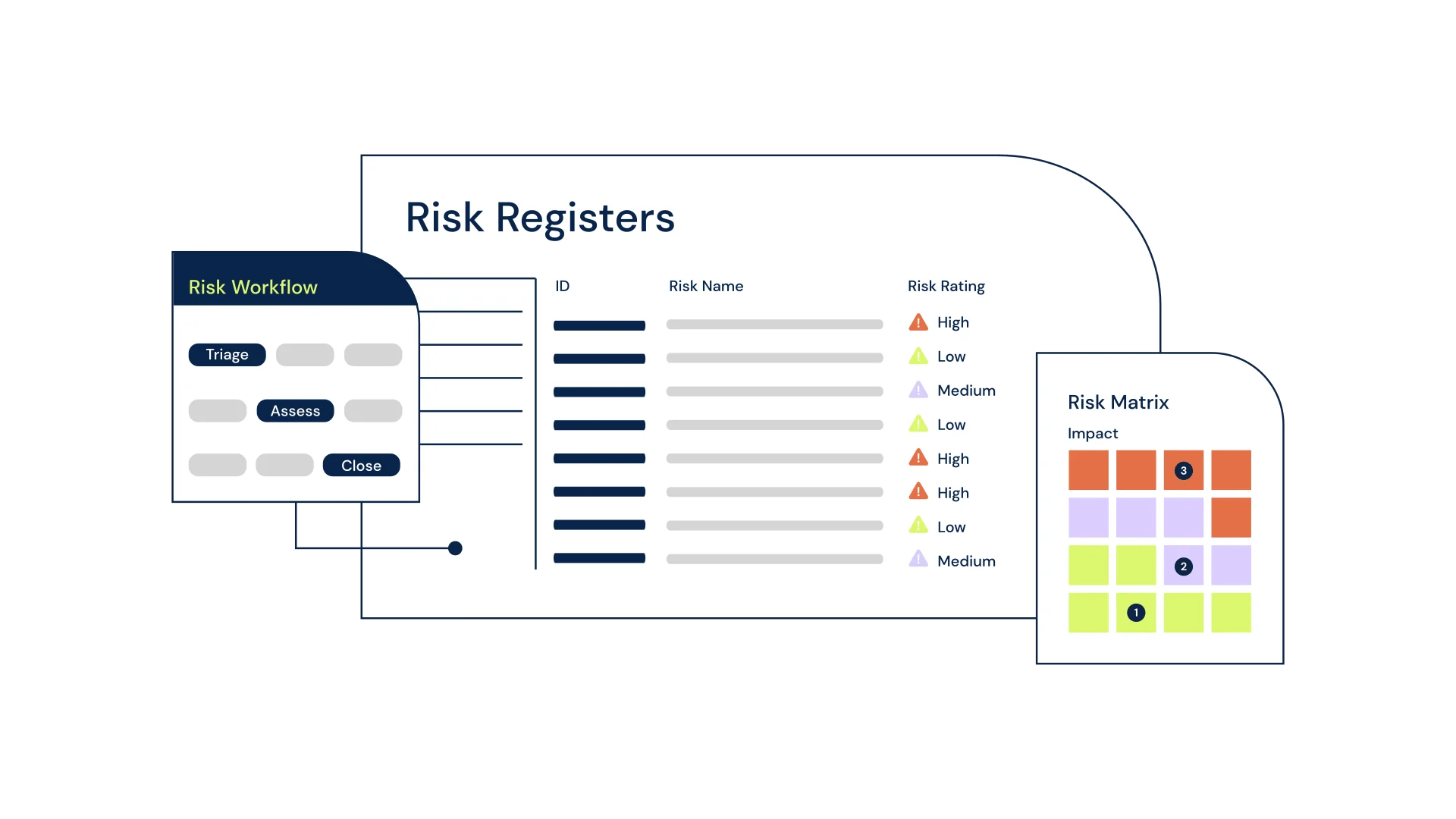What is a risk assessment?
A risk assessment is a systematic process that identifies, analyzes, and evaluates potential risks within an organization. Its purpose is to assess the level of risk associated with certain activities, decisions, or projects, and to implement control measures to mitigate or manage those risks effectively.
The risk assessment process involves several key components. First, it requires the identification of potential risks that could affect the organization's objectives, assets, or reputation. This could include financial risks, operational risks, cyber risks, legal risks, or any other risks specific to the industry or sector.
Once the risks are identified, they are analyzed to determine their potential impact and likelihood of occurrence. This analysis helps prioritize risks based on their significance, allowing organizations to allocate resources and attention accordingly.
After the risks are analyzed, control measures are implemented to reduce or eliminate the potential negative impacts of the identified risks. These measures could include policies, procedures, systems, or technologies that address the identified risks effectively. Regular monitoring and review of the control measures are also essential to ensure their ongoing effectiveness.
The significance of conducting a risk assessment lies in the fact that it helps organizations make informed decisions based on a thorough understanding of potential risks. By identifying and analyzing risks, organizations can proactively take steps to manage them, thereby minimizing potential damages, losses, or disruptions.
A risk assessment is a vital component of enterprise risk management. It enables organizations to systematically identify, analyze, and manage potential risks, thus protecting their assets and ensuring long-term success.
Understanding the importance and benefits of a risk assessment
A risk assessment is a critical tool for both individuals and organizations as it allows them to evaluate the likelihood of adverse events impacting their business, project, or investment. This evaluation provides valuable insights into potential risks and their potential impact, enabling informed decision-making and the implementation of necessary measures to mitigate those risks.
One of the key benefits of a risk assessment is the creation of awareness about potential risks. By conducting a comprehensive assessment, individuals and organizations can identify potential hazards and vulnerabilities that may have otherwise gone unnoticed. This heightened awareness helps them understand the potential consequences of these risks and take the necessary steps to mitigate them effectively.
Moreover, a risk assessment aids in identifying who may be at risk. By evaluating different aspects of a business or project, such as operations, employees, assets, and reputation, stakeholders who might be affected by identified risks can be pinpointed. This knowledge is crucial for developing targeted control programs and implementing measures that effectively address the risks.
Furthermore, a risk assessment allows for the prioritization of risks and control measures. Not all risks have the same level of significance or potential impact. By assessing and evaluating risks, organizations can determine which risks require immediate attention and allocate resources accordingly. This prioritization ensures that control programs are implemented in a strategic and effective manner.
Additionally, risk assessments come in two main approaches: quantitative analysis and qualitative analysis. The former involves using mathematical models and data to calculate the probability of risk events occurring and their potential impact, providing a more objective and numerical assessment. On the other hand, qualitative analysis relies on expert opinions, historical data, and industry standards for a more subjective evaluation of risks based on various factors that may not be easily quantifiable.
Understanding the importance of a risk assessment program adds another layer of significance to the process. A risk assessment program is a systematic and proactive approach taken by individuals and organizations to identify, evaluate, and manage potential risks. It provides a structured framework for conducting risk assessments regularly and consistently, making risk management an ongoing and integral part of the organization's operations.
Another important aspect of risk assessment is ensuring compliance with regulations. By identifying potential areas of non-compliance, organizations can take corrective measures to avoid legal and financial penalties. Additionally, risk assessments play a crucial role in protecting critical assets and data, especially in the face of cyber threats and data breaches. By identifying potential weaknesses in systems, organizations can develop measures to safeguard their assets and data effectively.
Understanding the importance of a risk assessment is crucial for individuals and organizations to proactively manage potential risks. By conducting a thorough risk assessment, they can create awareness of risks, identify stakeholders at risk, determine the need for control programs, prioritize risks and control measures, ensure compliance with regulations, and protect their critical assets and data. Overall, risk assessments enable better risk management and safeguard the interests of businesses, projects, and investments.
Key steps in conducting a risk assessment
Conducting a risk assessment is an essential part of the enterprise risk management process. It involves identifying, analyzing, and evaluating potential risks in order to develop effective risk management strategies. There are several key steps to consider when conducting a risk assessment.
Firstly, it is important to establish the scope and objectives of the assessment. This includes defining the specific areas or processes that will be evaluated and determining the desired outcomes of the assessment.
Next, the organization needs to gather relevant data and information. This can involve reviewing internal documents, conducting interviews or surveys, and analyzing historical data or industry standards.
Once the necessary information is collected, the risks need to be identified (if . This involves systematically identifying and documenting potential risks and vulnerabilities that may exist.
After the risks are identified, they need to be analyzed and evaluated. This involves assessing the likelihood and potential impact of each risk event. This can be done using qualitative or quantitative methods, depending on the organization's preferences and available resources.
Once the risks are analyzed, appropriate risk management strategies and control measures need to be developed. This includes identifying and implementing measures to mitigate, transfer, or accept the risks.
Finally, the risk assessment process should include regular monitoring and review. This ensures that the assessment remains up-to-date and effective in addressing new and evolving risks.
By following these key steps, organizations can conduct a thorough and effective risk assessment that helps them proactively manage potential risks and protect their assets.
Establishing the scope and objectives
Establishing the scope and objectives in a risk assessment is a critical first step in effectively managing enterprise risks. By defining the boundaries and purpose of the assessment, organizations can ensure a focused and targeted approach to risk identification and mitigation.
One of the primary objectives in establishing the scope is to clearly identify what the risk assessment will encompass. This involves determining the specific areas or processes that will be evaluated, as well as the assets or resources that will be considered. By clearly defining the boundaries, organizations can ensure that the assessment addresses all potential risks and vulnerabilities.
Additionally, it is important to establish the purpose of the risk assessment. This involves clarifying the goals and outcomes that the organization aims to achieve through the assessment. For example, the purpose may be to identify and prioritize risks for mitigation, assess the current risk management strategies, or evaluate the effectiveness of control measures.
When establishing the scope and objectives, key considerations should include the potential risks to be evaluated. This involves identifying the range of risks that the organization may face, such as financial risks, operational risks, or legal risks. It is also important to consider any specific areas or processes that should be included or excluded from the assessment, based on their relevance and potential impact on the organization's objectives.
Establishing the scope and objectives in a risk assessment is crucial for ensuring a comprehensive and targeted approach to risk management. By clearly defining the boundaries and purpose of the assessment, organizations can effectively identify and mitigate potential risks, ultimately enhancing their resilience and success.
Identifying potential risks
Identifying potential risks is a crucial step in the risk assessment process, especially in the context of enterprise risk management. By identifying potential risks, organizations can proactively analyze and manage these risks to protect their assets and ensure the continuity of their business operations.
During a risk assessment, it is important to consider various factors to ensure a comprehensive analysis of potential risks. This includes understanding how different assets, technologies, and people are exposed to risks. For example, considering the potential risks associated with data breaches or cyber-attacks can help organizations implement appropriate security measures to protect their digital assets.
Furthermore, assessing the probability of occurrence of these potential risks is essential. By understanding the likelihood of a risk event happening, organizations can allocate resources and prioritize risk mitigation efforts accordingly. For instance, if there is a high probability of an earthquake occurring in a specific region, organizations in that area may need to focus on implementing measures to mitigate the potential impact of such an event on their business operations.
Another crucial aspect of identifying potential risks is assessing their potential impacts on the business environment. This includes evaluating the potential financial, operational, reputational, or legal consequences that may arise from a risk event. By considering these potential impacts, organizations can make informed decisions and develop effective risk mitigation strategies.
To aid in the identification and evaluation of potential risks, organizations can leverage various risk assessment tools and software. These tools provide a structured approach to assess risks, facilitate data analysis, and generate valuable insights. For example, risk assessment software can assist in conducting quantitative and qualitative analysis, categorizing risks, and generating risk reports.
Identifying potential risks is an integral part of the risk assessment process in enterprise risk management. By considering factors such as risk exposure, probability of occurrence, and potential impacts on the business environment, organizations can effectively analyze and address potential risks to protect their assets and ensure business continuity. Utilizing risk assessment tools and software can further enhance the accuracy and efficiency of this process.
Analyzing and prioritizing risks
Analyzing and prioritizing risks is the next step in conducting a comprehensive risk assessment within an enterprise risk management framework. This process involves systematically identifying, evaluating, and organizing potential risks based on their likelihood and severity.
Firstly, to analyze risks, it is important to gather relevant information and data about the potential hazards and their impact on the organization. This may involve conducting interviews, reviewing historical data, and utilizing risk assessment tools. By analyzing these risks, organizations can understand their potential consequences and prioritize them accordingly.
Next, evaluating the likelihood and severity of potential risks is key to determining their level of risk. Likelihood refers to the probability of a risk event occurring, while severity pertains to the potential impact or consequences if the risk event were to happen. By assessing these two factors, organizations can prioritize risks based on their risk level. For example, risks with a high likelihood and severe consequences would be considered high priority.
To organize and prioritize risks, it is helpful to create a risk assessment chart or matrix. This tool allows organizations to visually depict and categorize risks based on their likelihood and severity. Typically, the chart or matrix is divided into different zones representing varying levels of risk, such as low, medium, and high. This helps in determining where to allocate resources and implement appropriate risk mitigation measures.
Analyzing and prioritizing risks involves gathering relevant information, evaluating the likelihood and severity of potential risks, and organizing them using a risk assessment chart or matrix. This process enables organizations to effectively understand and address risks within their enterprise risk management framework.
Developing mitigation strategies
Developing effective mitigation strategies is the next step in the risk assessment process, as it allows organizations to proactively address and manage identified risks. These strategies aim to reduce or eliminate the potential negative impacts of the risks on the organization.
The first step in developing mitigation strategies is evaluating the level of risk associated with each identified risk as discussed above. This involves assessing the likelihood of the risk occurring and the severity of its potential consequences. By considering these factors, organizations can determine the priority of each risk and allocate resources accordingly. Risks with a high likelihood and severe consequences would typically be assigned a higher priority.
Once the risks have been prioritized, organizations can move on to determining the most appropriate control measures to mitigate each risk. Control measures can encompass a range of actions, such as implementing safety protocols, utilizing protective equipment, updating or reinforcing organizational policies and procedures, or redesigning processes. The goal is to reduce the likelihood or impact of the risk event, or to eliminate it altogether.
When developing these strategies, it is important to consider both the likelihood and severity of consequences. By focusing on risks with a high likelihood of occurrence and severe potential consequences, organizations can effectively allocate resources and prioritize risk mitigation efforts. This ensures that mitigation strategies are tailored to address the most critical risks, leading to better risk management and protection of the organization.
Developing mitigation strategies based on the identified risks in the risk assessment involves evaluating the level of risk, determining the priority of each risk, and implementing appropriate control measures to reduce or eliminate the risk. Considering both the likelihood and severity of consequences is key to developing effective strategies. By doing so, organizations can enhance their risk management capabilities and safeguard their operations.
Implementing and monitoring controls
Implementing and monitoring controls is the last step of the risk assessment process in enterprise risk management. Once risks have been identified and evaluated, organizations need to develop and implement control measures to mitigate or eliminate these risks.
To implement controls, organizations should first identify the most effective measures based on their risk assessment findings. Control measures can include implementing safety protocols, improving training programs, enhancing physical security measures, or implementing technology solutions. The chosen controls should be based on their ability to reduce the likelihood or impact of the identified risks.
After implementing controls, it is essential to monitor their effectiveness. This involves regularly assessing whether the controls are working as intended and to what extent they are mitigating the identified risks. Organizations can establish monitoring mechanisms such as regular inspections, audits, and data analysis to ensure that controls are functioning properly. If any issues or gaps are identified during monitoring, appropriate corrective actions should be taken promptly.
It is important to note that while implementing permanent control measures is the ultimate goal, interim control measures should also be developed and implemented. These interim measures provide immediate risk reduction while permanent controls are being developed and prioritized. This approach ensures that risks are addressed in a timely manner and that interim controls are in place to minimize potential damages or harm.
By implementing and monitoring controls, organizations demonstrate their commitment to risk management and ensure the safety and security of their stakeholders. It is a proactive approach that helps in identifying vulnerabilities, reducing the potential impact of risks, and maintaining a safe working environment. Ultimately, implementing and monitoring controls is vital for effective risk mitigation and the successful execution of enterprise risk management strategies.
Best Practices for Effective Risk Assessment
Engaging cross-functional teams
Engaging cross-functional teams in the risk assessment process is essential for effective enterprise risk management. By involving personnel from different departments or roles, organizations can benefit from diverse perspectives and expertise, leading to a comprehensive identification and assessment of potential risks.
One of the key advantages of engaging cross-functional teams is the ability to bring together individuals with varied experiences and skill sets. Each team member can contribute their unique knowledge and understanding of their respective areas, providing a holistic view of potential risks. This approach ensures that all aspects of the business are considered, including operations, finance, legal, and compliance.
Collaboration and effective communication among team members are also crucial for a thorough analysis and mitigation of identified risks. By facilitating open discussions, cross-functional teams can share insights, raise concerns, and explore alternative viewpoints. This enables the team to identify not only the obvious risks but also the less apparent ones that may arise due to interdependencies between various departments.
Furthermore, involving cross-functional teams promotes a sense of ownership and accountability among individuals from different areas of the organization. When team members actively participate in the risk assessment process, they develop a better understanding of the potential risks and their impact on the business. This leads to informed decision-making and enhances risk management measures.
Engaging cross-functional teams in the risk assessment process brings diverse perspectives and expertise to identify and assess potential risks comprehensively. Collaboration and effective communication among team members contribute to a more informed and holistic approach to risk management. By involving individuals from different departments or roles, organizations can improve their ability to identify, assess, and mitigate risks across various aspects of the business.
Regular review and updates
Regular review and updates are crucial in the risk assessment process, especially in enterprise risk management. Risk assessment is a dynamic process that requires ongoing evaluation to ensure accuracy and relevance. By conducting regular reviews, organizations can identify and address potential risks in a timely manner, ultimately enhancing their risk management strategies.
Regular review ensures that the risk assessment remains accurate and up-to-date, considering changing risks in the business environment. External factors such as new regulations, market conditions, and emerging technologies can introduce new risks or change the level of existing risks. By reviewing the risk assessment periodically, organizations can identify these changes and adjust their risk management plans accordingly.
There are several reasons to conduct a review of the risk assessment. Significant changes in the workplace, such as alterations to processes, equipment, or personnel, can impact the level of risk. Changes in the business environment, such as market trends or economic conditions, can also necessitate a review. Additionally, a review should be conducted when the current assessment is no longer valid or does not accurately reflect the current risk landscape.
To sustain focus on risk assessment, organizations should make it a continuous event rather than a one-time activity. Risk assessment should be integrated into the organization's culture, with regular reviews incorporated into business processes. By doing so, organizations can proactively identify and manage risks on an ongoing basis, mitigating potential negative impacts on their operations.
Regular review and updates are vital in the risk assessment process, ensuring that organizations remain well-equipped to address changing risks in their business environment. By conducting regular reviews, organizations can proactively manage risks, enhance their risk management strategies, and make informed decisions to protect their assets and stakeholders.
Embracing technology and data analytics
Embracing technology and data analytics can greatly enhance the risk assessment process in enterprise risk management. Technology has revolutionized the way organizations collect and analyze relevant data for risk assessment, allowing for a more accurate and comprehensive understanding of potential risks.
Implementing risk management software offers a number of benefits. It provides a single platform for systematic risk assessment, enabling organizations to identify and prioritize risks based on their potential impact. With advanced features for data reporting and analysis, risk management software empowers compliance professionals and security teams to have real-time visibility into risk exposure. This helps in making informed decisions and taking proactive measures to address potential risks.
Moreover, risk management software eliminates organizational silos by automating workflow processes and fostering collaboration between different departments. By adopting a data-driven approach, organizations can align their risk management strategy with their business processes and ensure compliance with regulatory requirements.
Tools like 6clicks are designed to support businesses in effectively managing their risks and ensuring compliance with regulatory requirements. With its advanced features and user-friendly interface, it provides organizations with a comprehensive platform to identify, monitor, analyze, and mitigate risks.

Final thoughts
A comprehensive and effective risk assessment process involves several key considerations. Firstly, it is crucial to incorporate both qualitative and quantitative analysis in risk assessments. While qualitative assessment provides a subjective evaluation of risks based on expert judgment and experience, quantitative analysis brings objectivity by assigning numerical values to risks. The combination of these two approaches ensures a more comprehensive understanding of potential risks and enables organizations to prioritize and allocate resources effectively.
Additionally, it is important to emphasize the need for regular review and updates of risk assessments. Risks are dynamic and can change over time due to various factors such as technological advancements, regulatory changes, or shifts in the business environment. Regular review ensures that risk assessments remain relevant and up-to-date, enabling organizations to proactively identify and address emerging risks.
Furthermore, embracing technology and data analytics is a game-changer in risk assessment. Advanced data collection tools and systems, along with data analytics tools, enable organizations to gather and analyze vast amounts of data. This allows for a more holistic view of potential risks and facilitates the identification of patterns, trends, and correlations that may otherwise go unnoticed. Incorporating technology and data analytics into risk assessment processes empowers organizations to make more informed and data-driven decisions, develop targeted mitigation strategies, and allocate resources efficiently.
If you'd like to find out how 6clicks' risk management capability can help optimize and automate your risk assessments then please reach out to us below.
Written by Louis Strauss
Louis began his career in Berlin where he also founded Dobbel Berlin – Berlin’s curated search engine. Returning to Melbourne to join KPMG, Louis lead the development of software designed to distribute IP and create a platform for us by advisors and clients. While at KPMG, Louis also co-authored Chasing Digital: A Playbook for the New Economy. Louis is accomplished in stakeholder management, requirements gathering, product testing, refinement and project implementation. Louis also holds a Bachelor of Engineering and a Masters of Information Systems from the University of Melbourne.









